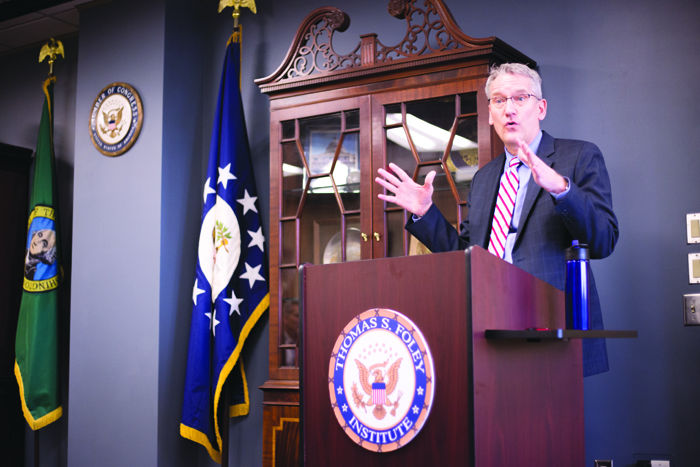Regulating marijuana
November 13, 2015
Information regarding marijuana use and health is often unclear, with various researchers and opinion groups fighting for control over the new legal frontier.
The Secretary of the Washington State Department of Health, John Wiesman, discussed marijuana and its effects on health Thursday afternoon at the Foley Speaker’s Room in Bryan Hall, as part of the University’s Coffee and Politics program.
Wiesman began by discussing how the recreational marijuana legislation in Washington came to pass, and how large of a role the public played in getting its voice heard.
He then discussed health effects that could be detected and researched with regulation.
“The choices made by communities we live in have a profound impact on our health and well-being; therefore, every person who is eligible to vote has the capacity and, more than that, the responsibility to determine the health of members of our communities,” Wiesman said.
Legislation to protect marijuana users was first introduced in Washington through a people’s ballot initiative in 1998. This initiative provided some protection for people who had marijuana for medicinal reasons.
However, the language in the bill was vague: the bill did not address where these patients could obtain the marijuana products.
In 2011, the federal government and the city of Seattle both announced that marijuana was their lowest priority. While marijuana was still illegal, the amount of medical dispensaries in the state began to grow.
“They grew until there were, allegedly, more medical dispensaries in Seattle than Starbucks,” Wiesman said.
However, these dispensaries remained unregulated, and therefore posed a danger to people, said Wiesman. Of these dangers, he cited yeast, E.coli and fungus, all of which could potentially affect users when no tests take place.
In November of 2012, the State of Washington legalized the use of recreational marijuana through Initiative 502.
Initiative 502 listed specific regulations around the growth, production and selling of marijuana products.
The first issue of marijuana regulation has been mostly solved, thanks to Washington Senate Bill 5052, which combined the medical and recreational markets.
There are two key concerns surrounding the effect of marijuana on youth that the DOH is concerned about.
The first: the safety of small children or the “gummy bear and 3-year-olds” example.
Marijuana-infused gummy bears could be dangerous to a child that is not aware it is not a normal candy. Doctors have reported that when very small children have encountered marijuana they have had respiratory issues, said Wiesman.
The second issue of concern was of older kids using the product. Marijuana can be addictive, especially for youth who are still growing and developing.
For example, kids who use marijuana before the age of 17 are twice as likely to become addicted, and about 1 in 6 teens that start using early become addicted, said Wiesman.
Marijuana use in adolescents is correlated with personality disorders and panic disorders, as well.
However, correlation does not mean causation. There is not enough research to prove a concrete causation.
“Previous research is mixed; 50 percent of research on people showed no effect in basic memory or function while the other 50 percent shows small effects,” said Carrie Cuttler, a clinical assistant professor of psychology.
Cuttler focuses on cognitive effects on individuals using different medications, including marijuana, in her research.
Reporting by Corinna Thornton





















